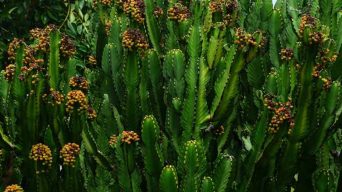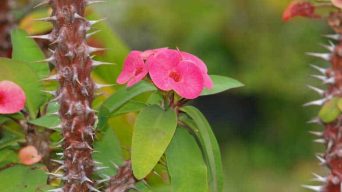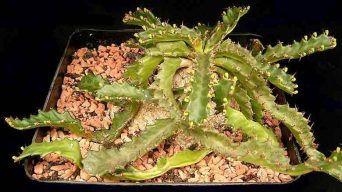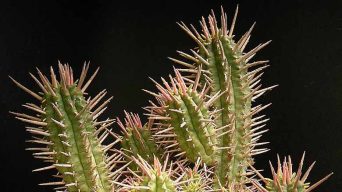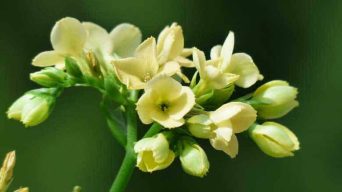The Euphorbia enopla, also known as the Pincushion Euphorbia plant, is a succulent that has been around for quite some time.
It’s easy to care for and propagate, making it a great choice if you’re looking to add something new and different to your home or office space.
In this article, we’ll go over everything you need to care for and propagate your own Euphorbia enopla plants successfully!
Overview
The Euphorbia enopla, also known as Pincushion Cactus, is an interesting and beautiful cactus.
It is a flowering plant in the family Euphorbiaceae, commonly known as Spurge family, native to the Cape Province of South Africa.
It is a succulent shrub with green branches up to 1.2 inches wide, and it has red spines on the edges.
The thorns on the Pincushion Euphorbia plant are 1.5 cm (0.6″) long when mature, but they can grow up to 3 cm (1.2″) in diameter with time and care.
This Euphorbia species is a candelabra-like succulent. The leaves are very small and fall off before adding any significant size to the plant.
When the plant blooms, you may see a dark red flower if it is female and a yellow flower if it is male.
Euphorbia enopla is often mistaken for Euphorbia ferox because they look similar.
But you can tell the difference between them by looking at their stems. E.enopla has thinner stems and less vibrant spines than E.ferox.
How To Care for Euphorbia Enopla ‘Pincushion Euphorbia’
Euphorbia enopla care is not hard to learn if you have a few basic rules.
The following are the most essential points to take care of Pincushion Euphorbia succulent plants.
Sun Exposure & Light Requirements
Euphorbia enopla can grow in full sun to partial shade but needs some protection from strong afternoon sun in the hottest summer months.
It needs at least 6 hours of sunlight each day.
When grown indoors, Euphorbia enopla must be close enough to a window providing plenty of bright light. A south-facing window is ideal as it will provide light all day.
Outdoors, the Pincushion plant thrives under protection from the afternoon sun and prefers filtered morning or late-afternoon sun for more even coloring and fewer burns on the leaves.
Watering Requirements
Euphorbias are drought tolerant plants and do not require regular watering.
However, they still need water to grow well and flower.
They only require watering when the soil feels dry on top after about one week of being watered or if it starts feeling crispy when you touch it.
Euphorbia enopla’s natural growing habitat is mostly semi-arid rocky hillsides where little rain falls so that it can easily handle extended periods without water.
Still, it would be best if you tried to water at least once a month or when rainfall is abundant.
The best time of day to do this is in the morning so that by nightfall, the plant has had enough time to dry out before night temperatures drop.
Soil Requirements
The soil requirements for the succulent plant of the Euphorbia enopla ‘Pincushion’ are relatively simple.
In general, it needs a well-drained mix of sand and loamy matter to be happy. A cactus mix or succulent potting mix will work well.
Alternatively, you can mix your own soil with a 50/50 combination of potting soil and sand or use pure Perlite.
Temperature and Humidity
The Euphorbia enopla care routine is relatively easy to maintain.
The plant grows best in warm or cool temperatures with a minimum of 50% humidity year-round, making it an excellent houseplant for dry environments.
For optimal growth and coloration, the daytime temperature should be between 70°F (21°C) and 80°F (27°C), while nighttime temps can drop down to 55-65°F (13-18°C).
Fertilizing
The Euphorbia enopla ‘Pincushion’ plant does not require any additional fertilizing.
However, it can benefit from occasional applications of water-soluble fertilizer mixed at half strength to boost plants lagging in their growth cycle.
The soil should also be watered the following application thoroughly and at anytime during extreme heat spells when rain is unlikely.
Potting and Repotting
The Euphorbia enopla plant comes in a variety of shapes and sizes. It is best to start with the largest pot possible when it is time for repotting or potting up your plants.
The pots should be about two inches larger on all sides than what they are currently potted in.
To pot and repot the Euphorbia enopla, you will need a well-drained succulent mix or an equal mixture of sand and peat moss.
Fill up the new pot with soil to about one inch below where your plant’s roots grow out from their current container.
Add water until it seeps through the drainage holes in the bottom of your pots.
Wait for five minutes, then pour off any excess liquid that is leftover on top of your plant’s root system before adding more soil mix around them so they can grow taller and fuller while filling all areas equally within the pot.
Once appropriately planted, water your plants well and place them in a location that receives six hours of direct sunlight daily.
Pruning
The Euphorbia enopla needs a thorough annual pruning after it blooms.
Remove dead stems and spindly growths from the previous year’s flower show while preserving healthy new growth below those cuts so that they remain sturdy enough to support their flowers next season.
The plant will produce new stems and leaves at the base of healthy, pruned areas.
This is normal for all succulents, so it’s important not to cut too far down into the center or roots when trimming.
Infected plants should be removed entirely with no cutting involved to prevent the spread of disease.
Pests and Diseases
Pests are not a problem for the Euphorbia enopla ‘Pincushion Euphorbia’ succulent plant.
Insects may chew on the leaves and cause leaf spots, but this is rare in well-fed plants.
The only pest that can be problematic to any degree is scale insects because of their ability to secrete honeydew and contribute to black mold growth, which will eventually kill the plant if its infestation becomes too severe.
The best way to control these pests is by using a soap spray.
If the insect population becomes too large, it’s also possible to use a fine mist from an atomizer that contains pyrethrins (insecticide) or neem oil (a natural pesticide).
Otherwise, aphids can be controlled with water-based sprays of dishwashing liquid or soapy solution, and caterpillars can be removed manually.
The only actual disease seen with this succulent plant is leaf spot caused by insect damage or excessively wet soil conditions.
This condition generally manifests in small brown spots at first but then progresses to larger lesions that eventually kill the tissue, leaving white scars behind where new growth emerges from below.
Leaf spot can be prevented by spraying an organic fungicide such as neem oil or Bordeaux mixture (a solution of copper sulfate and lime).
Aside from these few potential pests/diseases, there should be no other issues for this Euphorbia enopla
How to Care for Euphorbia Enopla ‘Pincushion Euphorbia’ in Winter
Pincushion Euphorbia winter care is the same as any other succulent.
During the winter months, when Euphorbia enopla plants are kept indoors, they need less sunlight but still require about six hours per day for best growth results with the indirect sun (such as through an east-facing window or a south-facing window in the winter).
Since these succulents are dormant during this time, they don’t need as much water. Water about once every two weeks unless it is unusually cold, and then you may want to water at least once per month but never let them dry out completely.
It’s also important not to fertilize your Euphorbia enopla plants during their dormancy period because that will encourage growth, causing leaves to grow, which can be more susceptible to frost damage.
Pincushion Euphorbias do not like temperatures below 40 degrees Fahrenheit, so bring them indoors before that temperature is reached if possible, or be prepared for some potential frost damage which can include brown edges on leaves due to cold weather exposure.
For this reason, many gardeners choose to keep their plants outdoors year-round since winters tend not to fall too far below freezing.
How To Propagate Euphorbia Enopla ‘Pincushion Euphorbia’
The Euphorbia enopla ‘Pincushion Euphorbia’ can be propagated by cuttings, offsets, and seeds.
Cuttings
It is possible to propagate the Euphorbia enopla plant by taking cuttings.
- Remove the cuttings from the parent plant by taking them with a clean razor blade or sharp, sterilized scissors.
- Remove any leaves on the cutting and use your fingers to snap off the tough lower part of each leaf petiole (the stem).
- Allow cuttings to dry out for at least two days before planting in the soil if you plan to root inside pots indoors.
- Cuttings can also be planted in soil outdoors as long as they are placed into a well-draining container with plenty of root hormone powder to ensure success.
- Pot up the cuttings with good quality potting soil and ensure that the top of each cutting is at least an inch below the surface.
- Use a light misting to moisten your new plants before placing them in full sun exposure for best results.
It will take about two weeks for new roots to form, but using a rooting hormone can speed up the process.
Once the roots are formed, water generously and give them plenty of sun exposure to continue growing strong.
Offsets
Offsets will form at the base of a Euphorbia enopla plant.
The offsets will resemble miniature versions of the parent and should be removed from the plant as soon as they are noticed for best results.
Remove the offsets from the parent plant by gently twisting them out of their resting place with a clean, sterilized finger.
Allow offsets to dry for at least two days before planting in the soil as long as they are placed into pots indoors.
Offsets can also be planted outdoors if given plenty of light exposure and well-draining soil in containers or raised beds.
Pot up your Euphorbia enopla offset plants with good quality potting soil and ensure that each new set is an inch below surface level.
A rooting hormone may be used to speed up the process, but it’s not necessary when using this propagation method.
It will take about two weeks for roots to form and water generously.
Again, give them plenty of sun exposure to grow strong!
Seeds
If you choose to propagate the Euphorbia enopla succulent by seed, start with fresh seeds.
Germinate them in standard potting soil mix and use a well-draining container for best results.
Keep your new seedlings warm but not too hot nor cold as they grow from their initial stages until they reach at least four inches tall before transplanting outdoors or into pots indoors if desired.
Pot up plants individually and place them an inch below surface level using good quality potting soil or rooting hormone powder to help speed up the process.
It will take about two weeks for new roots to form once exposed to plenty of sun exposure!
Is the Euphorbia Enopla ‘Pincushion Euphorbia’ Toxic?
The Euphorbia enopla can be toxic to humans and animals. Keep out of reach of children and animals, including pets!
The milky sap can cause contact dermatitis for individuals sensitive to it and soreness or swelling of the skin around the area where the plant touches a person.
The Euphorbia enopla is not edible due to its toxic properties when ingested by humans and other mammals.
However, they are consumed by many birds that do not have an issue with ingesting them because their stomachs contain chemicals that destroy these toxins before they reach the bloodstream.
It is recommended to use gloves when handling the plant.
Final Thoughts
The Euphorbia enopla is a great plant to have in your home or office.
If you’re looking for a plant that’s easy to maintain, the Euphorbia enopla will be perfect.
If you take care of it well, then this succulent will thrive for years!


